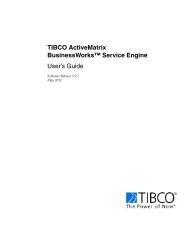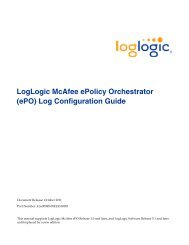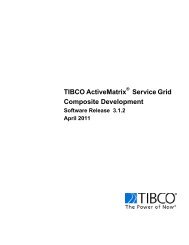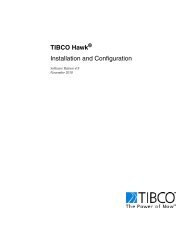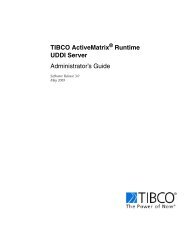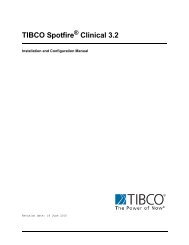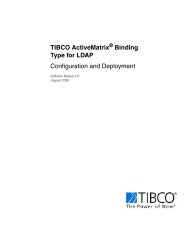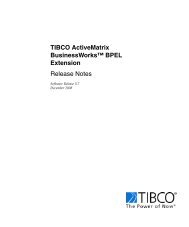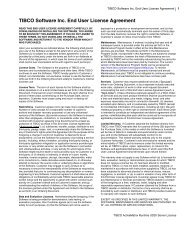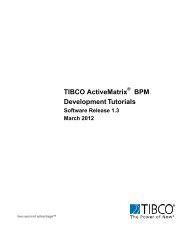- Page 1:
TIBCO ® MDMCustomization GuideSoft
- Page 4 and 5:
iv| Contents4 - Bottom Left Part .
- Page 6 and 7:
vi| ContentsUsing FileWatcher. . .
- Page 8 and 9:
viii| ContentsCreating Locale-speci
- Page 10 and 11:
x| TablesTIBCO MDM Customization Gu
- Page 12 and 13:
xii| FiguresTIBCO MDM Customization
- Page 14 and 15:
xiv Changes from the Previous Relea
- Page 16 and 17:
xvi| Related Documentation • TIBC
- Page 18 and 19:
xviii Connecting with TIBCO Resourc
- Page 20 and 21:
2 Chapter 1 Customizing Roles, Menu
- Page 22 and 23:
4 Chapter 1 Customizing Roles, Menu
- Page 24 and 25:
6 Chapter 1 Customizing Roles, Menu
- Page 26 and 27:
8 Chapter 1 Customizing Roles, Menu
- Page 28 and 29:
10 Chapter 1 Customizing Roles, Men
- Page 30 and 31:
12 Chapter 1 Customizing Roles, Men
- Page 32 and 33:
14 Chapter 1 Customizing Roles, Men
- Page 34 and 35:
16 Chapter 1 Customizing Roles, Men
- Page 36 and 37:
18 Chapter 2 Customizing User Inter
- Page 38 and 39:
20 Chapter 2 Customizing User Inter
- Page 40 and 41:
22 Chapter 2 Customizing User Inter
- Page 42 and 43:
24 Chapter 2 Customizing User Inter
- Page 44 and 45:
26 Chapter 2 Customizing User Inter
- Page 46 and 47:
28 Chapter 2 Customizing User Inter
- Page 48 and 49:
30 Chapter 2 Customizing User Inter
- Page 50 and 51:
32 Chapter 2 Customizing User Inter
- Page 52 and 53:
34 Chapter 2 Customizing User Inter
- Page 54 and 55:
36 Chapter 2 Customizing User Inter
- Page 56 and 57:
38 Chapter 2 Customizing User Inter
- Page 58 and 59: 40 Chapter 2 Customizing User Inter
- Page 60 and 61: 42 Chapter 2 Customizing User Inter
- Page 62 and 63: 44 Chapter 2 Customizing User Inter
- Page 64 and 65: 46 Chapter 2 Customizing User Inter
- Page 66 and 67: 48 Chapter 2 Customizing User Inter
- Page 68 and 69: 50 Chapter 2 Customizing User Inter
- Page 70 and 71: 52 Chapter 2 Customizing User Inter
- Page 72 and 73: 54 Chapter 2 Customizing User Inter
- Page 74 and 75: 56 Chapter 2 Customizing User Inter
- Page 76 and 77: 58 Chapter 2 Customizing User Inter
- Page 78 and 79: 60 Chapter 2 Customizing User Inter
- Page 80 and 81: 62 Chapter 2 Customizing User Inter
- Page 82 and 83: 64 Chapter 2 Customizing User Inter
- Page 84 and 85: 66 Chapter 2 Customizing User Inter
- Page 86 and 87: 68 Chapter 2 Customizing User Inter
- Page 88 and 89: 70 Chapter 2 Customizing User Inter
- Page 90 and 91: 72 Chapter 2 Customizing User Inter
- Page 92 and 93: 74 Chapter 2 Customizing User Inter
- Page 94 and 95: 76 Chapter 2 Customizing User Inter
- Page 96 and 97: 78 Chapter 2 Customizing User Inter
- Page 98 and 99: 80 Chapter 2 Customizing User Inter
- Page 100 and 101: 82 Chapter 2 Customizing User Inter
- Page 102 and 103: 84 Chapter 2 Customizing User Inter
- Page 104 and 105: 86 Chapter 2 Customizing User Inter
- Page 106 and 107: 88 Chapter 2 Customizing User Inter
- Page 110 and 111: 92 Chapter 3 Customizing Repository
- Page 112 and 113: 94 Chapter 3 Customizing Repository
- Page 114 and 115: 96 Chapter 3 Customizing Repository
- Page 116 and 117: 98 Chapter 3 Customizing Repository
- Page 118 and 119: 100 Chapter 3 Customizing Repositor
- Page 120 and 121: 102 Chapter 4 Customizing Inbox|Cus
- Page 122 and 123: 104 Chapter 4 Customizing Inbox|Tab
- Page 124 and 125: 106 Chapter 4 Customizing Inbox|Cus
- Page 126 and 127: 108 Chapter 4 Customizing Inbox|Ena
- Page 128 and 129: 110 Chapter 5 Customizing Business
- Page 130 and 131: 112 Chapter 5 Customizing Business
- Page 132 and 133: 114 Chapter 5 Customizing Business
- Page 134 and 135: 116 Chapter 5 Customizing Business
- Page 136 and 137: 118 Chapter 5 Customizing Business
- Page 138 and 139: 120 Chapter 5 Customizing Business
- Page 140 and 141: 122 Chapter 6 FileWatcher|FileWatch
- Page 142 and 143: 124| Chapter 6 FileWatcher These di
- Page 144 and 145: 126| Chapter 6 FileWatcher filename
- Page 146 and 147: ImportClassificationSchemeImport cl
- Page 148 and 149: 130 Chapter 6 FileWatcher|Classific
- Page 150 and 151: 132| Chapter 6 FileWatcher Supplier
- Page 152 and 153: 134 Chapter 6 FileWatcher|ActionsEx
- Page 154 and 155: 136| Chapter 6 FileWatcher MYSETLoa
- Page 156 and 157: 138| Chapter 6 FileWatcher MyInputM
- Page 158 and 159:
140| Chapter 6 FileWatcher ENT1 Exp
- Page 160 and 161:
142| Chapter 6 FileWatcher UDEXPurg
- Page 162 and 163:
RetentionUnitsSpecifies the numbero
- Page 164 and 165:
146| Chapter 6 FileWatcher You can
- Page 166 and 167:
148 Chapter 6 FileWatcher|Using Fil
- Page 168 and 169:
150| Chapter 6 FileWatcher Users ca
- Page 170 and 171:
152 Chapter 6 FileWatcher|Processin
- Page 172 and 173:
154| Chapter 6 FileWatcher Watchdog
- Page 174 and 175:
156| Chapter 6 FileWatcher Exportin
- Page 176 and 177:
158| Chapter 6 FileWatcher EAN.UCCp
- Page 178 and 179:
160 Chapter 6 FileWatcher|TIBCO MDM
- Page 180 and 181:
162 Chapter 7 Customizing Data Sync
- Page 182 and 183:
164 Chapter 7 Customizing Data Sync
- Page 184 and 185:
166 Chapter 7 Customizing Data Sync
- Page 186 and 187:
168 Chapter 7 Customizing Data Sync
- Page 188 and 189:
170 Chapter 7 Customizing Data Sync
- Page 190 and 191:
172 Chapter 7 Customizing Data Sync
- Page 192 and 193:
174 Chapter 7 Customizing Data Sync
- Page 194 and 195:
176 Chapter 7 Customizing Data Sync
- Page 196 and 197:
178 Chapter 8 Customizing Generic S
- Page 198 and 199:
180 Chapter 8 Customizing Generic S
- Page 200 and 201:
182 Chapter 8 Customizing Generic S
- Page 202 and 203:
184 Chapter 8 Customizing Generic S
- Page 204 and 205:
186 Chapter 8 Customizing Generic S
- Page 206 and 207:
188 Chapter 9 Setting up GPC Classi
- Page 208 and 209:
190 Chapter 9 Setting up GPC Classi
- Page 210 and 211:
192 Chapter 9 Setting up GPC Classi
- Page 212 and 213:
194 Chapter 10 Setting up Data Qual
- Page 214 and 215:
196 Chapter 10 Setting up Data Qual
- Page 216 and 217:
198 Chapter 10 Setting up Data Qual
- Page 218 and 219:
200 Chapter 10 Setting up Data Qual
- Page 220 and 221:
202 Chapter 10 Setting up Data Qual
- Page 222 and 223:
204 Chapter 10 Setting up Data Qual
- Page 224 and 225:
206 Chapter 10 Setting up Data Qual
- Page 226 and 227:
208 Chapter 10 Setting up Data Qual
- Page 228 and 229:
210 Chapter 10 Setting up Data Qual
- Page 230 and 231:
212 Chapter 10 Setting up Data Qual
- Page 232 and 233:
214 Chapter 10 Setting up Data Qual
- Page 234 and 235:
216 Chapter 10 Setting up Data Qual
- Page 236 and 237:
218 Chapter 10 Setting up Data Qual
- Page 238 and 239:
220 Chapter 10 Setting up Data Qual
- Page 240 and 241:
222 Chapter 10 Setting up Data Qual
- Page 242 and 243:
224 Chapter 10 Setting up Data Qual
- Page 244 and 245:
226 Chapter 10 Setting up Data Qual
- Page 246 and 247:
228 Chapter 10 Setting up Data Qual
- Page 248 and 249:
230 Chapter 10 Setting up Data Qual
- Page 250 and 251:
232 Chapter 10 Setting up Data Qual
- Page 252 and 253:
234 Chapter 10 Setting up Data Qual
- Page 254 and 255:
236 Chapter 10 Setting up Data Qual
- Page 256 and 257:
238 Chapter 10 Setting up Data Qual
- Page 258 and 259:
240 Chapter 11 Localizing Text Stri
- Page 260 and 261:
242 Chapter 11 Localizing Text Stri
- Page 262 and 263:
244 Chapter 11 Localizing Text Stri
- Page 264 and 265:
246 Chapter 11 Localizing Text Stri
- Page 266 and 267:
248 Chapter 11 Localizing Text Stri
- Page 268 and 269:
250 Chapter 11 Localizing Text Stri
- Page 270 and 271:
252 Chapter 11 Localizing Text Stri
- Page 272 and 273:
254 Chapter 11 Localizing Text Stri
- Page 274 and 275:
256 Chapter 11 Localizing Text Stri
- Page 276 and 277:
258 Chapter 11 Localizing Text Stri
- Page 278 and 279:
260 Chapter 11 Localizing Text Stri
- Page 280 and 281:
262 Chapter 11 Localizing Text Stri
- Page 282 and 283:
264 Chapter 11 Localizing Text Stri
- Page 284 and 285:
266 Chapter 11 Localizing Text Stri
- Page 286 and 287:
268 Chapter 11 Localizing Text Stri
- Page 288 and 289:
270 Chapter 12 Setting up Data Extr
- Page 290 and 291:
272 Chapter 12 Setting up Data Extr
- Page 292 and 293:
274 Chapter 12 Setting up Data Extr
- Page 294 and 295:
276 Chapter 12 Setting up Data Extr
- Page 296:
278| IndexGGenerateReportForSDD 236





